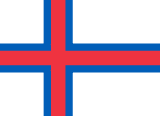Faroe Islands

About Faroe Islands
The Faroe Islands, or the Faroes (also written Faeroes; pronounced ; Faroese: Føroyar, pronounced [ˈfœɹjaɹ]; Danish: Færøerne), are a North Atlantic archipelago located 320 kilometres (200 mi) north-northwest of Scotland, and about halfway between Norway and Iceland. Like Greenland, it is an autonomous territory within the Kingdom of Denmark. The islands have a total area of about 1,400 square kilometres (540 sq mi) with a population of 52,703 as of September 2020.The terrain is rugged; the climate is subpolar oceanic climate (Cfc)—windy, wet, cloudy, and cool. Temperatures average above freezing throughout the year because of the Gulf Stream. As a result of the moderation and the northerly latitude, summers normally hover around 12 °C (54 °F). Average temperatures are 5 °C (41 °F) in winter. The northerly latitude location also results in perpetual civil twilight during summer nights and very short winter days.
Between 1035 and 1814, the Faroe Islands were part of the Kingdom of Norway, which was in a personal union with Denmark from 1450. In 1814, the Treaty of Kiel transferred Norway to the King of Sweden, on the winning side of the Napoleonic Wars, whereas Denmark retained the Faroe Islands, along with Greenland and Iceland.
While part of the Kingdom of Denmark, the Faroe Islands have been self-governing since 1948, controlling most areas apart from military defence, policing, justice, currency, and foreign affairs. Because the Faroe Islands are not part of the same customs area as Denmark, the country has an independent trade policy, and can establish trade agreements with other states. The Faroes have an extensive bilateral free trade agreement with Iceland, known as the Hoyvík Agreement. In the Nordic Council, they are represented as part of the Danish delegation. In certain sports, the Faroe Islands field their own national teams.
Tórshavn
Tórshavn (Faroese: [ˈtʰɔuʂhaun]; lit. 'Thor's harbour'; Danish: Thorshavn, pronounced [ˈtsʰoɐ̯ˀsˌhɑwˀn]) is the capital and largest city of the Faroe Islands. It is in the southern part on the east coast of Streymoy. To the northwest of the city lies the 347-meter-high (1,138 ft) mountain Húsareyn, and to the southwest, the 350-meter-high (1,150 ft) Kirkjubøreyn. They are separated by the Sandá River. The city itself has a population of 19,165 (2019), and the greater urban area has a population of 21,078.
The Norse (Scandinavians) established their parliament on the Tinganes peninsula in AD 850. Tórshavn thus became the capital of the Faroe Islands and has remained so ever since. Early on, Tórshavn became the centre of the islands' trade monopoly, thereby being the only legal place for the islanders to sell and buy goods. In 1856, the trade monopoly was abolished and the islands were left open to free trade.